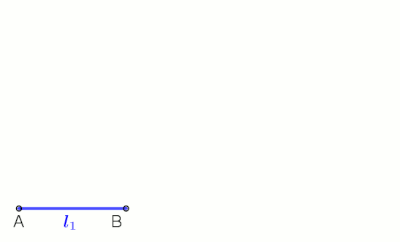
In mathematics, the geometric mean is a mean or average which indicates a central tendency of a finite collection of positive real numbers by using the product of their values (as opposed to the arithmetic mean which uses their sum). The geometric mean of numbers is the nth root of their product, i.e., for a collection of numbers a1, a2, ..., an, the geometric mean is defined as
When the collection of numbers and their geometric mean are plotted in logarithmic scale, the geometric mean is transformed into an arithmetic mean, so the geometric mean can equivalently be calculated by taking the natural logarithm of each number, finding the arithmetic mean of the logarithms, and then returning the result to linear scale using the exponential function ,
The geometric mean of two numbers is the square root of their product, for example with numbers and the geometric mean is . The geometric mean of the three numbers is the cube root of their product, for example with numbers , , and , the geometric mean is .
The geometric mean is useful whenever the quantities to be averaged combine multiplicatively, such as population growth rates or interest rates of a financial investment. Suppose for example a person invests $1000 and achieves annual returns of +10%, -12%, +90%, -30% and +25%, giving a final value of $1609. The average percentage growth is the geometric mean of the annual growth ratios (1.10, 0.88, 1.90, 0.70, 1.25), namely 1.0998, an annual average growth of 9.98%. The arithmetic mean of these annual returns – 16.6% per annum – is not a meaningful average because growth rates do not combine additively.
The geometric mean can be understood in terms of geometry. The geometric mean of two numbers, and , is the length of one side of a square whose area is equal to the area of a rectangle with sides of lengths and . Similarly, the geometric mean of three numbers, , , and , is the length of one edge of a cube whose volume is the same as that of a cuboid with sides whose lengths are equal to the three given numbers.
The geometric mean is one of the three classical Pythagorean means, together with the arithmetic mean and the harmonic mean. For all positive data sets containing at least one pair of unequal values, the harmonic mean is always the least of the three means, while the arithmetic mean is always the greatest of the three and the geometric mean is always in between (see Inequality of arithmetic and geometric means.)
- ^ Matt Friehauf, Mikaela Hertel, Juan Liu, and Stacey Luong "On Compass and Straightedge Constructions: Means" (PDF). UNIVERSITY of WASHINGTON, DEPARTMENT OF MATHEMATICS. 2013. Retrieved 14 June 2018.
- ^ "Euclid, Book VI, Proposition 13". David E. Joyce, Clark University. 2013. Retrieved 19 July 2019.








![{\displaystyle {\sqrt[{n}]{a_{1}a_{2}\cdots a_{n}{\vphantom {t}}}}.}](https://wikimedia.org/api/rest_v1/media/math/render/svg/60029eff3729e2e87568e79e09c1b98d96f5c4a0)


![{\displaystyle {\sqrt[{n}]{a_{1}a_{2}\cdots a_{n}{\vphantom {t}}}}=\exp \left({\frac {\ln a_{1}+\ln a_{2}+\cdots +\ln a_{n}}{n}}\right).}](https://wikimedia.org/api/rest_v1/media/math/render/svg/0ee8301029750e6cdb5ac0e993419e488efb3879)







![{\displaystyle \textstyle {\sqrt[{3}]{1\cdot 12\cdot 18}}={}}](https://wikimedia.org/api/rest_v1/media/math/render/svg/331e564561091ac436e14c39c9109df1fabee44a)
![{\displaystyle \textstyle {\sqrt[{3}]{216}}=6}](https://wikimedia.org/api/rest_v1/media/math/render/svg/ef9f3e0b2e31c3b498afeff8fe335fb80a5bb403)


